At KDD 2018, Airbnb researchers published a paper called Customized Regression Model for Airbnb Dynamic Pricing. This article describes the dynamic pricing model used by Airbnb. The following is a general introduction to the article by Lunzhi.
The purpose of price optimization is to help the landlord set the best price. The traditional pricing strategy is to price a large number of the same products, but Airbnb does not have the same products, because the houses provided by the platform have unique value and experience. Such uniqueness makes it difficult to estimate the demand curve required by traditional pricing strategies.
"The strategy model proposed by the researcher has been applied on Airbnb for more than a year. As soon as the first-generation model was used, the number of bookings on the website has been greatly increased, and the benefits of hosts who have adopted this method have also increased. After many iterations, the strategy model will further improve the quality of pricing."
It is very challenging to price all the different rooms on Airbnb. Even if we can collect rooms of the same size in the same area, other factors (such as star rating) will also affect the price. In addition, due to different seasons and regional factors, demand fluctuates over time. Similarly, the early or late reservation is also a factor that affects the price. The later the reservation is, the smaller the chance of a successful room reservation, which will also lead to changes in the demand function.
In order to maximize the benefits of the landlord, Airbnb proposed "Price Tips" and "Smart Pricing" tools. Price Tips can provide a price calendar, which shows the probability that the room will be booked every day according to the current price of the landlord. Click on a certain day, the page will show Airbnb recommended prices and other information.
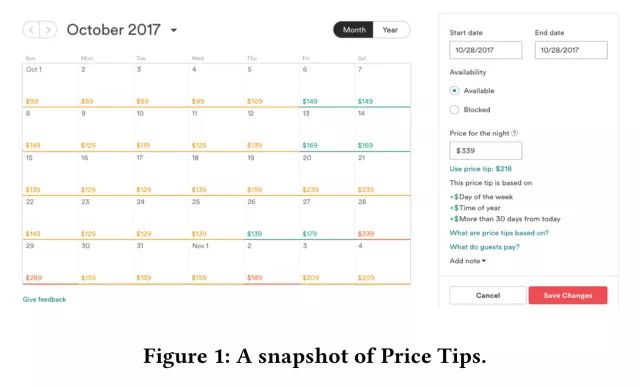
Price Tips screenshot
In the Smart Pricing tool, the host can set a minimum and maximum value, and then Airbnb will automatically generate new prices for different dates.
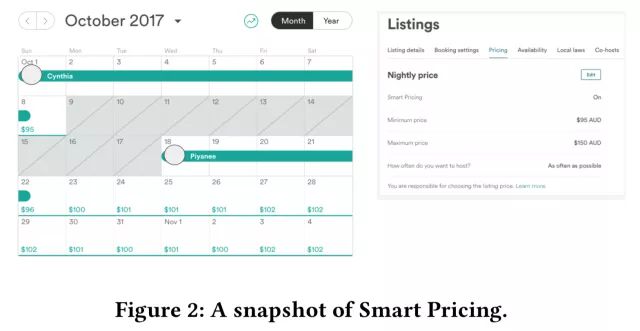
Smart Pricing screenshot
Under ideal circumstances, we would estimate a demand curve F(P), estimate the demand for a room at a given price P, and then choose the value of P to maximize the value of P×F(P). We have mentioned before that there are many factors affecting prices, and since Airbnb does not directly control room prices, but can only give "recommended prices", we want to directly experiment with different pricing strategies to observe the market. The reaction is not easy.
The pricing system finally adopted by Airbnb has three elements:
A binary classification model predicts the probability of booking a room on a certain night.
These predictions will then be input into a pricing strategy model, and suggested prices will be proposed for free dates.
The strategy model will add other personalized logic to meet the landlord’s goals, combine special events, and so on.
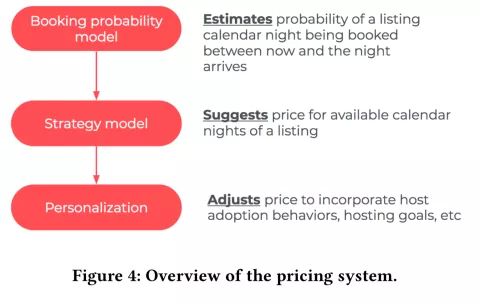
Pricing system overview
The main purpose of this paper is the pricing strategy model, but we must first briefly understand the details of the predetermined probability model.
Predetermined probability model
I want to know how likely a room will be booked. Here is Gradient Boosting Machines (GBM). In addition, there is a model trained for each market. The sampling rate of training data varies according to the density of each market:
"Markets with high housing density benefit the most from geographic location, where the sampling rate will be higher than the global constant sampling rate."
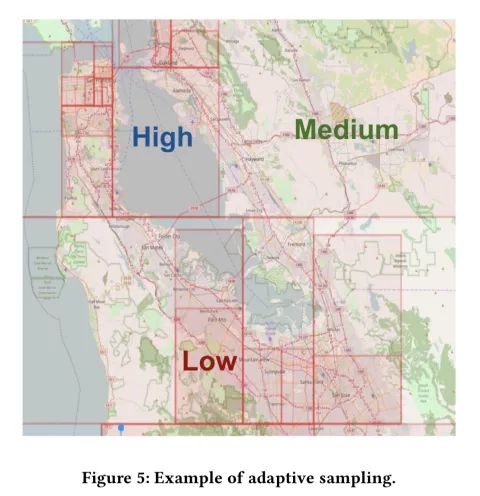
The model considers three aspects when making decisions:
The features listed on the page, such as the price per night, room type, number of occupants, number of rooms, number of toilets, room facilities, location, reviews, historical occupancy rates, availability of immediate reservations, and so on.
Time factors, such as season, date, check-in time, etc.
Supply factors, such as whether there are similar listings nearby, reviews, search rates, etc.
The model predicts the predetermined probability at different price points, and may get a demand curve. However, due to the above-mentioned multiple influencing factors, it is very difficult to obtain an accurate demand curve for price setting.
"We tried to directly apply profit maximization strategies based on the estimated demand curve, but online A/B test results showed that these methods usually fail in practice. Therefore, we decided to find other alternative methods."
The substitution method uses the output result of the predetermined probability model as one of the input factors of the pricing strategy model.
Pricing strategy model
Let us first think about: In the absence of an optimal price, what evaluation scale should be used when training a pricing strategy model?
After careful consideration, the research team determined two evaluation criteria: price drop recall rate (PDR) and scheduled estoppel rate (BR). We have counted whether a certain room is booked out on a certain day, and what the booked price is. Both PDR and BR can reflect this.
Suppose that if a room cannot be successfully booked at a price P, then it must not be booked at a price higher than P. But if the price is lower than P, then there may be a chance to be booked. PDR represents the proportion of unreserved rooms when the actual price is higher than the suggested price of the model. In the chart below, the PDR is 0.6 (3 out of 5 nights are not booked).
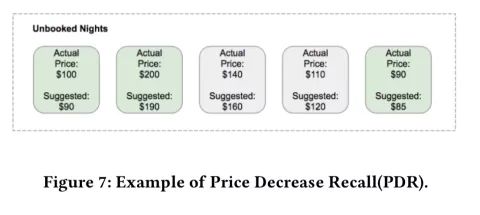
If we only have PDR, then the model we trained will eventually change the guide price to zero! If the room is successfully booked one day, the price is P, and P ≥ the guide price, then the guide price is useless. The booking remorse rate captures this profit. BR is calculated according to the following method: For all successfully booked days, take the largest value among zero and the percentage between the predetermined price and the guide price. Then take the median from these values.
E.g:
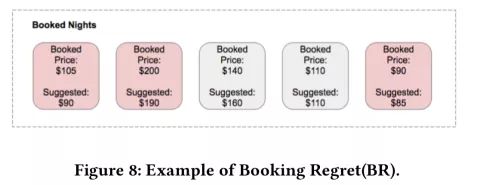
BR is the median of (14, 5, 6, 0, 0), 5%.
Now we combine these ideas into a single loss function, which looks like this:

Given the parameter xi, fθ(xi) is the recommended price of the output, L is the lower limit function, and U is the upper limit function.
For the booked out date, the lower limit is the predetermined price Pi, and for the unbooked date, it is c1Pi, where c1 is a constant between 0 and 1.
For days that are not booked out, the upper limit is the price Pi in the price calendar. For the days booked out, the upper limit is c2Pi, where c2 is a constant greater than 1.

When the recommended price is between the upper and lower limits, the loss is zero, otherwise the loss is the distance between the recommended price and the limit.
In the paper, the author mentioned:
"We don't use the same constant to express price increase and decrease, because we want the training system to learn the ratio asymmetrically. In this way, the recommended price can reflect the sensitivity of demand."
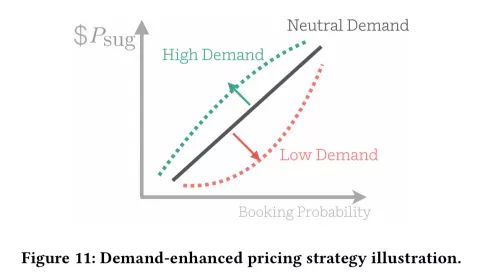
The parameters θ1 and θ2 are trained in more than 4 million effective listings on Airbnb. The training pays more attention to the recent predetermined behavior, so as to better reflect the seasonal signal.
Evaluation
Compared with the simple strategy of estimating curve pricing directly from the demand in the predetermined probability model, the pricing strategy model significantly improves PDR and BR.
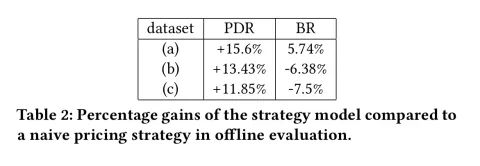
In addition to the quantitative evaluation, the author of the paper also checked the prices of the next 120 nights generated on February 8, 2018. The following figures are for the housing price trends in Tokyo, Japan and Lake Tahoe, California:
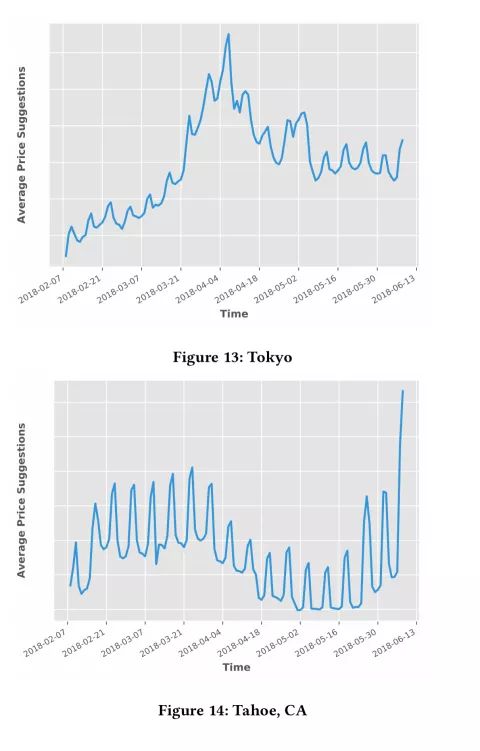
It can be seen that the room prices in both places have risen during the weekend, and the prices in Tokyo are relatively high from the end of March to the beginning of April, because that is a good time for cherry blossom viewing. "From these two cases, we see that the model can indeed capture the fluctuations in house prices brought about by time," the researcher said.
Led Neon Flex ,Neon Flex Adalah,Flexible Led Neon Strip Lights,Led Neon Tube Lights
NINGBO SENTU ART AND CRAFT CO.,LTD. , https://www.lightworld-sentu.com
